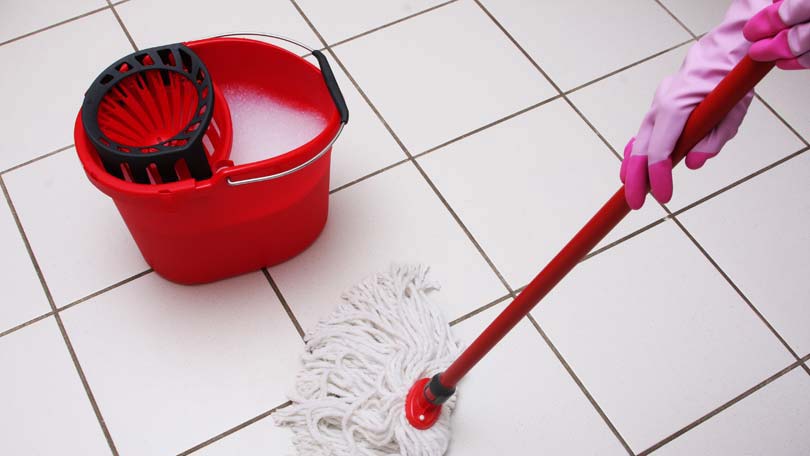
There are a number of different types of tile floors, the most common being vinyl, ceramic, and linoleum. Cleaning tile floors is very easy, but different cleaning products work best on each of these types of flooring, so before you clean, know which floor you are working with.
Cleaning Ceramic Tile Floors
Ceramic tile is man-made, and often used on floors because it can be made in almost any color, size, and thickness. There are two main types of ceramic tile – glazed and unglazed, and both are installed with grout that must be cleaned as well. To clean glazed or unglazed ceramic tiles, use 1 gallon of warm water, 1 tablespoon of borax, 2 tablespoons of ammonia (clear kind), and a microfiber mop. Do not use a sponge mop to clean ceramic tile because it will push the dirt and grime into the grout tracks; a microfiber mop will actually pick up the dirt as you sweep it across the floor, keeping the grout from becoming even more dirty. Mop in a circular motion across the tiles. For extremely dirty grout, use a spray bottle to shoot the cleaning solution directly into the grout tracks, mopping over the area immediately once sprayed. For the grout, a stronger cleaning solution can be used, like Oxiclean diluted to ‘heavy duty cleaning’ specifications which are found on the container. Go over the floors with plain water after cleaning to remove any remaining residue from the cleaner.
Cleaning Vinyl Floors
Vinyl flooring is offered in more varieties of colors and patterns than any other floor covering available. It is quite resilient, resistant to scratching, staining, and tearing, and replicates the look of ceramic tile at a much lower cost. Vinyl tiles can be self-adhesive (you peel off the backing and stick them to the floor!), or can be applied with glue. Either way, cleaning vinyl tiles is very simple. To make a cleaning solution, dilute ½ cup of ammonia in 1 gallon of warm water. Abrasive detergents or mop-and-shine products will leave a film on the floor, so ammonia or a manufacturer recommended cleaning solution works best. Using a soft mop or cloth, apply the cleaning solution to the floor in a circular motion. To remove scuff marks, you can use a pencil eraser, toothpaste, or even baking soda. If the scuff mark is still showing, dampen a sponge with mild dishwashing soap and scrub the scuff until it is gone. On vinyl tile, rubber or latex-backed mats can cause staining, so use woven rugs or ‘vinyl-safe’ mats instead.
Cleaning Linoleum Floors
Linoleum flooring is similar to vinyl (many people confuse the two), but linoleum is made from natural ingredients while vinyl is made from synthetic materials. Linoleum flooring is actually made mostly of linseed oil that is boiled down and then mixed with resins, wood flour, and other ingredients. Pigments are added within the mixture for color, and the linoleum is backed with a woven sheet. It is long-wearing, does not scratch as easily as vinyl, and when it does scratch, it holds color because the pattern is embedded in the material, not just stamped on the top layer. Most linoleum is polished or waxed for protection. For heavy cleaning, strip the wax from the flooring following the manufacturer instructions. Fill a spray bottle with 50% vinegar and 50% water, and fill a bucket with warm water. Spray the cleaning solution directly onto the linoleum, and use a damp mop or cloth to wipe the cleaner over the floor surface. Although linoleum is durable, it can be damaged by excessive moisture so use water sparingly. For regular cleaning, use a diluted all-purpose cleaner making sure to rinse well. For added shine, put a cup of vinegar in with your all-purpose cleaner dilution.
To test whether your flooring is vinyl or linoleum, scrape off a layer with a razor blade (obviously you want to do this on an inconspicuous area of the floor). If the color or design comes off, you have vinyl; if the color stays, you have linoleum. If this is not an option, just buy cleaner that is safe for both vinyl and linoleum floors.
Tile floors, whether ceramic, vinyl, or linoleum, are very durable, and come in a huge variety of choices. Spending a short amount of time cleaning tile floors can keep them in perfect condition for many years. For the best outcome, sweep or vacuum tile floors every two days, mop every other week, and deep clean a few times a year.
